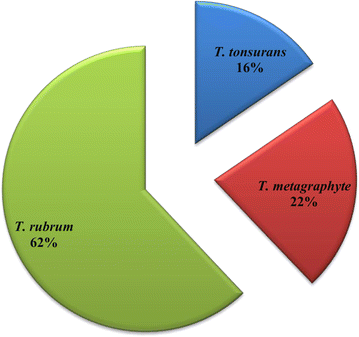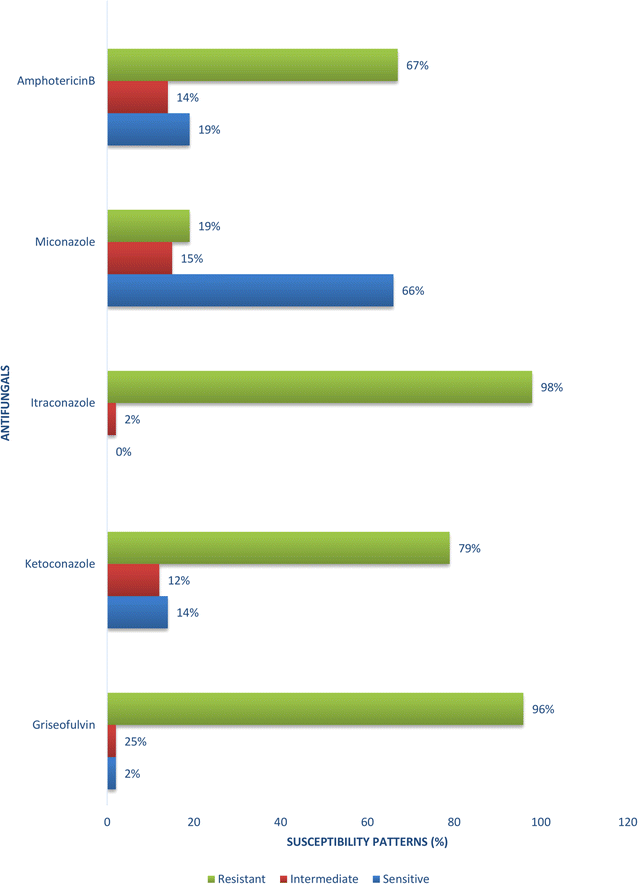Onychomycosis in diabetic patients in Fako Division of Cameroon: prevalence, causative agents, associated factors and antifungal sensitivity patterns
- PMID: 27876085
- PMCID: PMC5120551
- DOI: 10.1186/s13104-016-2302-1
Onychomycosis in diabetic patients in Fako Division of Cameroon: prevalence, causative agents, associated factors and antifungal sensitivity patterns
Abstract
Background: Onychomycosis is an infection of the nail unit by a fungus. This is a very common infection amongst diabetics. Its occurrence among diabetics in Fako division is unknown. In this study we provide information on the characteristics of onychomycosis in diabetics in Fako division, Cameroon.
Methods: A cross-sectional descriptive and analytical hospital-based study was conducted in two diabetic clinics in the Buea and Limbe regional hospitals. We recruited 152 consenting diabetics into the study. Demographic, behavioural, and clinical data of patients were obtained through the use of structured questionnaires. Toenail, finger nail, skin scrapings and nail clippings were collected from participants, KOH mounts were prepared and observed under the microscope and cultured on Sabouraud Dextrose Agar supplemented with chloramphenicol to isolate causative fungi. Identification of isolates was done to species level using the cello tape flag method and slide culture. The presence of a dermatophyte by either microscopy or culture or both methods was considered positive for onychomycosis. Antifungal susceptibility testing was carried out using selected antifungals by the Kirby-Bauer disk diffusion method on Sabouraud Dextrose Agar.
Results: Clinical onychomycosis was found in 77 of the 152 diabetics tested giving a prevalence of 50.7% (95% CI 42.4-58.9) in diabetics in Fako. No socio-demographic or clinical factor studied was significantly associated with onychomycosis. Trichophyton rubrum was the most common isolate (62%). Other isolates included Trichophyton metagraphyte (22%) and Trichophyton tonsurans (16%). Dermatophytes were sensitive to miconazole (66%), amphotericin B (19%) and ketoconazole (14%).
Conclusion: Onychomycosis is common in diabetics in Fako signifying the need for regular screening by either microscopy or culture. Infected nails could be treated with miconazole.
Keywords: Antifungal susceptibility; Cameroon; Diabetic; Fako; Onychomycosis; Prevalence; Risk factors.
Figures
References
-
- Puri N, Kaur T. Onychomycosis: a clinical and mycological study of 75 cases. Our Dermatol Online. 2012;3:172–177. doi: 10.7241/ourd.20123.39. - DOI
-
- Krall LP, Bradley RF. Editor’s Joslin’s diabetes mellitus. 12. Philadelphia: Lea-Febiger; 1985.
-
- Lynch LE, Gupta AK. Onychomycosis: review of recurrence rates, poor prognostic factors, and strategies to prevent disease recurrence. Cutis. 2004;74:10–15. - PubMed
-
- Salgo PL, Daniel CR, Gupta AK, Mozena JD, Joseph SW. Onychomycosis disease management. Med Crossfire. 2003;4:1–17.
MeSH terms
Substances
LinkOut - more resources
Full Text Sources
Other Literature Sources
Medical



